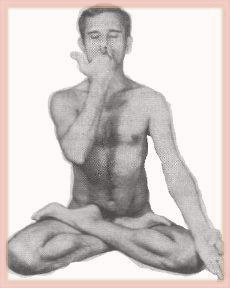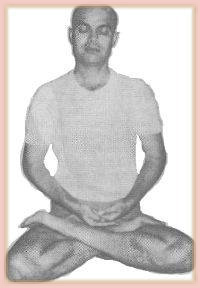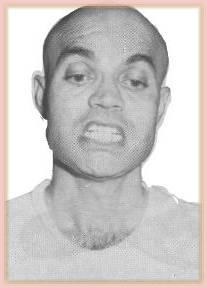|
Surya
Bheda
|
|

|
Sit on Padmasana or
Siddhasana. Close the eyes. Keep the left nostril closed with your right ring
and little fingers. Slowly inhale without making any sound as long as you can
do it comfortably through the right nostril. Then close the right nostril with
your right thumb and retain the breath firmly pressing the chin against the
chest (Jalandhara Bandha). Hold on the breath till perspiration oozes from the
tips of the nails and roots of the hairs (hair follicles). This point cannot be
reached at the very outside. You will have to increase the period of Kumbhaka
gradually. This is the limit of the sphere of practice of Surya Bheda Kumbhaka. |
|
|
|
|
|
|
| Then
exhale very slowly without making any sound through the left nostril by closing
the right nostril with the thumb. Repeat OM mentally with Bhava and meaning
during inhalation, retention and exhalation. Exhale after purifying the skull
by forcing the breath up.
|
|
|
|
| This
Pranayama removes all diseases, purifies the Nadis, steadies the mind in
concentration, improves digestion, increases the digestive fire and appetite,
helps to maintain Brahmacharya and awakens the Kundalini that is sleeping at
the Muladhara Chakra. Purification of Nadis will set in rapidly. You will have
levitation (rising above the ground) also.
|
|
|
|
Ujjayi
|
|
|
|
| Sit in Padmasana or
Siddhasana. Close the mouth. Inhale slowly through both the nostrils in a
smooth, uniform manner till the breath fills the space from the throat to the
heart.
Retain the breath as long as you
can do it comfortably and then exhale slowly through the left nostril by
closing the right nostril with your right thumb. Expand the chest when you
inhale. During inhalation a peculiar sound is produced owing to the partial
closing of glottis. The sound produced during inhalation should be of a mild
and uniform pitch. It should be continuous also. This Kumbhaka may be practised
even when walking or standing. Instead of exhaling through the left nostril,
you can exhale slowly through both nostrils.
|

|
|
|
|
|
| This
removes the heat in the head. The practitioner becomes very beautiful. The
gastric fire is increased. It removes all the evils arising in the body and the
Dhatus and cures Jalodara (dropsy of the belly or ascites). It removes phlegm
in the throat, Asthma, consumption and all sorts of pulmonary diseases are
cured. All diseases that arise from deficient inhalation of oxygen, and
diseases of the heart are cured. All works are accomplished by Ujjayi
Pranayama. The practitioner is never attacked by diseases of phlegm, nerves,
dyspepsia, dysentery, enlarged spleen, consumption, cough or fever. Perform
Ujjayi to destroy decay and death.
|
|
|
|
Sitkari
|
|
|
|

|
Fold the tongue so
that the tip of the tongue might touch the upper palate and draw the air
through the mouth with a hissing sound C C C C (or Si, Si, Si, Si). Then retain
the breath as long as you can without the feeling of suffocation and then
exhale slowly through both nostrils. You can keep the two rows of teeth in
contact and then inhale the air through the mouth as before.
The practice enhances the beauty of the practitioner and vigour of his body. It
removes hunger, thirst, indolence and sleep. His strength will be just like
that of Indra. He becomes the Lord of Yogins.
|
|
|
|
|
| In
this Pranayama you need not close the nostrils. Simply close the eyes if you
practise it in a sitting posture. Forget the body and concentrate. If you
practise this during walking, just feel minutely the movement of the air that
is inhaled and exhaled.
|
|
| He
is able to do and undo things. He becomes an independent monarch. He becomes
invincible. No injury will affect him. When you are thirsty, practise this. You
will be relieved of thirst immediately.
|
|
|
|
Sitali
|
|
|
|
| Protrude
the tongue a little away from the lips. Fold the tongue like a tube. Draw in
the air through the mouth with the hissing sound Si. Retain the breath as long
as you can hold on with comfort. Then exhale slowly through both nostrils.
Practise this daily again and again in the morning from 15 to 30 times. You can
do this either on Padmasana, Siddhasana, Vajrasana or even when you stand or
walk.
|
|
|
|
| This
Pranayama purifies the blood. It quenches thirst and appeases hunger. It cools
the system. It destroys Gulma (chronic dyspepsia), Pleeha, inflammation of
various chronic diseases, fever, consumption, indigestion, bilious disorders,
phlegm, the bad effects of poison, snake-bite, etc. When you are caught up in a
jungle or any place where you cannot get water, if you feel thirsty, practise
this Pranayama. You will be at once relieved of thirst. He who practices this
Pranayama regularly, will not be affected by the bite of serpents and
scorpions. Sitali Kumbhaka is an imitation of the respiration of a serpent. The
practitioner gets the power of casting his skin and enduring the privation of
air, water and food. He becomes a proof against all sorts of inflammations and
fever.
|
|
|
|
Top
|
|
|
|
Bhastrika
|
|
|
|
| In
Sanskrit Bhastrika means ‘bellows’. Rapid succession of forcible expulsion is a
characteristic feature of Bhastrika. Just as a blacksmith blows his bellows
rapidly, so also you should move your breath rapidly.
|
|
|
|
| Sit
on Padmasana. Keep the body, neck and head erect. Close the mouth. Next, inhale
and exhale quickly ten times like the bellows of the blacksmith. Constantly
dilate and contract. When you practise this Pranayama a hissing sound is
produced. The practitioner should start with rapid expulsions of breath
following one another in rapid succession. When the required number of
expulsions, say ten for a round, is finished, the final expulsion is followed
by a deepest possible inhalation. The breath is suspended as long as it could
be done with comfort. Then deepest possible exhalation is done very slowly. The
end of this deep exhalation completes one round of Bhastrika. Rest a while
after one round is over by taking a few normal breaths. This will give you
relief and make you fit for starting the second round. Do three rounds daily in
the morning. You can do another three rounds in the evening also. Busy people
who find it difficult to do three rounds of Bhastrika can do one round at
least. This also will keep them quite fit.
|
|
|
|
| Bhastrika
is a powerful exercise. A combination of Kapalabhati and Ujjayi makes up
Bhastrika. Practise Kapalabhati and Ujjayi to start with. Then you will find it
very easy to do Bhastrika.
|
|
|
|
| Some
prolong the practice till they get tired. You will get perspiration profusely.
If you experience any giddiness stop the practice and take a few normal
breaths. Continue the practice after the giddiness has vanished. Bhastrika can
be done both in the morning and evening in winter. In summer do it in the
morning only during cool hours.
|
|
|
|
| Bhastrika
relieves inflammation of the throat, increases gastric fire, destroys phlegm,
removes diseases of the nose and chest and eradicates asthma, consumption, etc.
It gives good appetite. It breaks the three Granthis or knots viz., Brahma
Granthi, Vishnu Granthi and Rudra Granthi. It destroys phlegm which is the bolt
or obstacle to the door at the mouth of Brahma Nadi (Sushumna). It enables one
to know the Kundalini. It removes all diseases which arise from excess of wind,
bile and phlegm. It gives warmth to the body. When you have no sufficient warm
clothing in a cool region to protect yourself from cold, practise this
Pranayama and you will get sufficient warmth in the body quickly. It purifies
the Nadis considerably. It is the most beneficial of all Kumbhakas. Bhastrika
Kumbhaka should be specially practised as it enables the Prana to break through
the three Granthis or knots that are firmly located in the Sushumna. It awakens
the Kundalini quickly. The practitioner will never suffer from any disease. He
will always be healthy.
|
|
|
|
| The
number of exhalations or rounds is determined by the strength and capacity of
the practitioner. You must not go to extremes. Some students do six rounds.
Some do twelve also.
|
|
|
|
| You
can practise Bhastrika in the following manner. There is some slight change in
the end. Having inhaled and exhaled quickly twenty times, inhale through the
right nostril, retain the breath as long as you can do it comfortably and then
exhale through the left nostril. Then inhale through the left nostril, retain
the breath as before and then exhale through the right nostril.
|
|
|
|
| Repeat
OM mentally with Bhava and meaning throughout the practice.
|
|
|
|
| There
are some varieties of Bhastrika wherein one nostril only is used for breathing
purposes and in another variety the alternate nostrils are used for inhalation
and exhalation.
|
|
|
|
| Those
who wish to do Bhastrika for a long time in an intense manner should live on
Khichdi, and take an enema or do Bhasti in the morning before starting the
practice.
|
|
|
|
Top
|
|
|
|
|
|
|
|
|
|
|
|
|
|
|
|
|
|
|
|
|
|
|
|
|
|
|
|
|
|
|
|
|
|
|
Site
Developed, Hosted & Maintained By:
Vijai Kumar Lunia
email : aryabhattastro@gmail.com |



